Peonies are beloved for their stunning blooms and delightful fragrance, making them a favorite in gardens worldwide. These perennial flowers are relatively easy to grow with the right care, providing a burst of color and beauty each spring and summer. Whether you’re a seasoned gardener or a beginner, growing peonies can be a rewarding experience.
To successfully cultivate peonies, it’s essential to understand their specific needs, including sunlight, soil conditions, and proper maintenance. With a little attention and patience, your garden can flourish with the captivating beauty of peonies, adding timeless elegance and charm to your landscape for years to come.
Understanding Peonies

Peonies are among the most cherished flowers, prized for their captivating beauty and versatility in garden settings. With proper care, these perennials can live for decades, often blooming more prolifically with each passing year. Their ability to thrive in diverse climates and add timeless charm to landscapes makes them a gardener’s favorite.
What Are Peonies?
Peonies are perennial plants admired for their large, showy flowers that bloom in late spring to early summer. These flowers come in a variety of colors, including pink, red, white, and yellow, making them a favorite among gardeners. Their sturdy stems and lush foliage also add a touch of elegance to any garden.
The peony plant has a long history and symbolic meaning, often representing prosperity, romance, and good fortune. Originating in Asia and Europe, they have been cultivated for centuries for their beauty and medicinal properties.
Types of Peonies
There are three main types of peonies: herbaceous, tree, and intersectional (Itoh). Herbaceous peonies die back to the ground in winter and regrow in spring, while tree peonies have woody stems that remain year-round. Intersectional peonies are hybrids combining the best traits of the other two types.
Each type of peony has its unique characteristics, making them suitable for different gardening preferences. Whether you prefer the robust tree peonies or the delicate herbaceous varieties, there’s a peony type for every gardener.
Read More: How to Keep Cut Peonies Fresh
Choosing the Right Spot for Peonies
Selecting the perfect location is essential for peony growth. Choose a site with good air circulation to prevent fungal diseases and ensure healthy blooms. Avoid planting near large trees or shrubs, as their roots can compete with peonies for nutrients and water, potentially stunting growth.
Sunlight Requirements
Peonies thrive in full sun, requiring at least six hours of direct sunlight daily to produce vibrant blooms. Planting them in a sunny location ensures healthy growth and abundant flowers. Avoid planting them in shady areas, as this can lead to weak stems and fewer blooms.
While peonies enjoy the sun, they also benefit from some afternoon shade in hot climates. This helps protect their delicate flowers from scorching and prolongs their blooming period.
Soil Conditions
Peonies prefer well-draining soil with a slightly acidic to neutral pH level (6.5-7). Rich, fertile soil enriched with organic matter like compost or aged manure promotes healthy root development and vigorous growth.
Ensure the soil is free from waterlogging, as peonies are susceptible to root rot in overly wet conditions. Amending heavy clay or sandy soil with organic matter can improve its structure and drainage capabilities.
Preparing to Plant Peonies
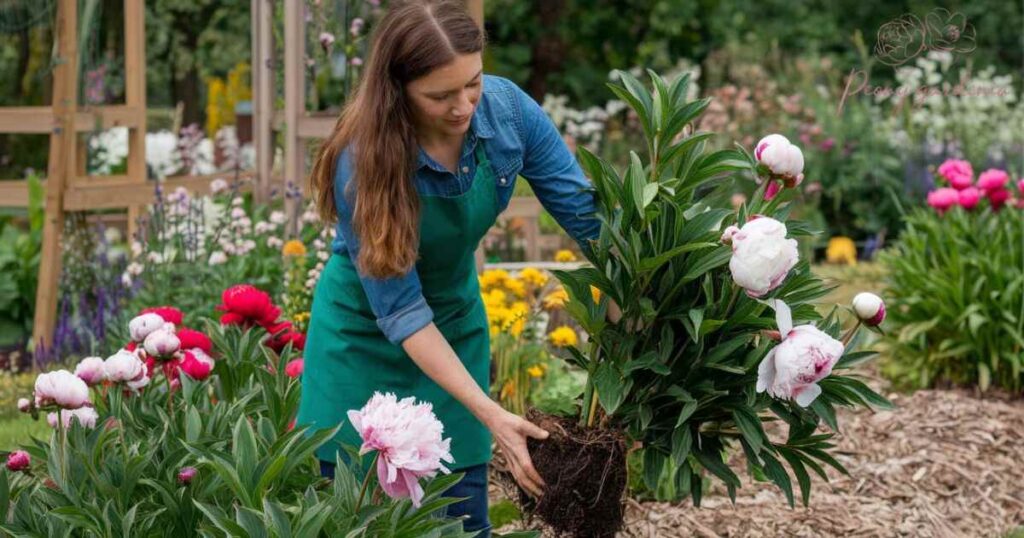
Preparing to plant peonies involves selecting the right climate and location. Plant them in the fall, ensuring the soil is well-draining with a slightly acidic to neutral pH. Choose a spot with at least six hours of sunlight and ample air circulation, avoiding areas with competing roots from nearby trees or shrubs.
Climate Considerations
Peonies are hardy plants that thrive in USDA zones 3-8, tolerating cold winters and warm summers. They require a period of winter dormancy to bloom effectively, making them ideal for temperate regions with seasonal changes.
If you live in a warmer climate, choose heat-tolerant varieties and plant them where they receive some shade during the hottest part of the day. Mulching can also help regulate soil temperature and retain moisture.
Planting Peonies
The best time to plant peonies is in the fall, typically between late September and early November. This allows the roots to establish before winter. Dig a hole twice as wide and deep as the root ball, ensuring enough space for root growth.
Place the peony tuber with its eyes (buds) facing upward, about 1-2 inches below the soil surface. Cover with soil and water thoroughly. Avoid planting too deeply, as this can prevent blooming.
Caring for Your Peonies
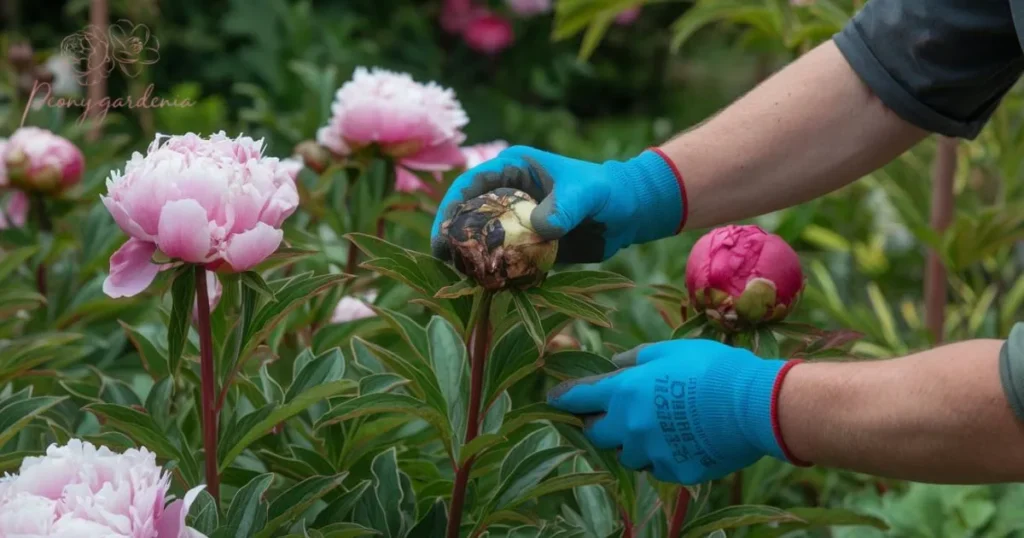
Caring for peonies involves regular watering, especially during their first year, ensuring the soil remains moist but not soggy. Fertilize in early spring with a balanced, low-nitrogen fertilizer to encourage blooms. Prune spent flowers, remove dead foliage, and mulch around the base to protect roots and retain moisture.
Watering Needs
Peonies require consistent watering, especially during their first year of growth. Deep watering once a week is sufficient, providing about an inch of water to keep the soil evenly moist but not soggy.
During hot or dry weather, increase watering frequency to prevent stress. Mature peonies are more drought-tolerant but still benefit from regular watering during blooming periods.
Fertilizing Peonies
Apply a balanced fertilizer in early spring as new growth emerges to encourage robust blooms. A low-nitrogen fertilizer, such as a 10-20-20 mix, is ideal for peonies, as it supports flower production without excessive foliage growth.
Avoid over-fertilizing, as this can lead to lush foliage with few flowers. Mulching with organic matter also provides nutrients and helps retain soil moisture.
Managing Common Peony Problems
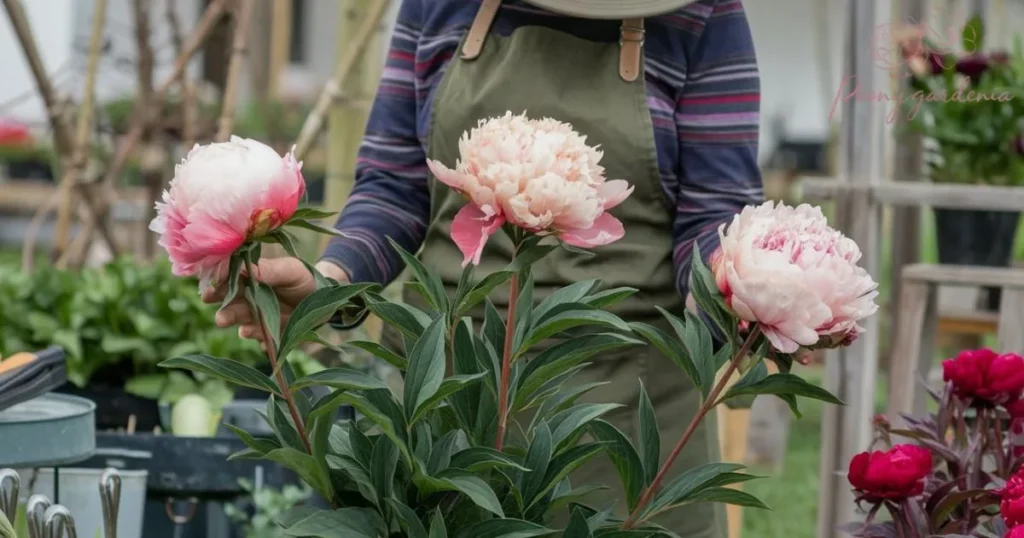
Managing common peony problems involves addressing pests like ants, aphids, and thrips by spraying with water or insecticidal soap. To prevent fungal diseases such as botrytis blight and powdery mildew, ensure proper air circulation, prune dead foliage, and avoid overhead watering. Regular maintenance helps keep plants healthy and thriving.
Pest Control
Peonies are relatively pest-resistant but can occasionally attract ants, aphids, or thrips. Ants are generally harmless and often attracted to the sweet nectar on peony buds.
For aphids or thrips, spray the plants with a strong stream of water to dislodge the pests or use insecticidal soap for severe infestations. Regular inspection and good garden hygiene help prevent major issues.
Disease Prevention
Peonies can be affected by fungal diseases such as botrytis blight and powdery mildew. These issues are often caused by excess moisture and poor air circulation. Prune dead or diseased foliage promptly to reduce the risk.
Space peonies adequately during planting and avoid overhead watering to keep the leaves dry. Using a fungicide as a preventative measure during wet seasons can also help.
Maintaining Peonies Year-Round
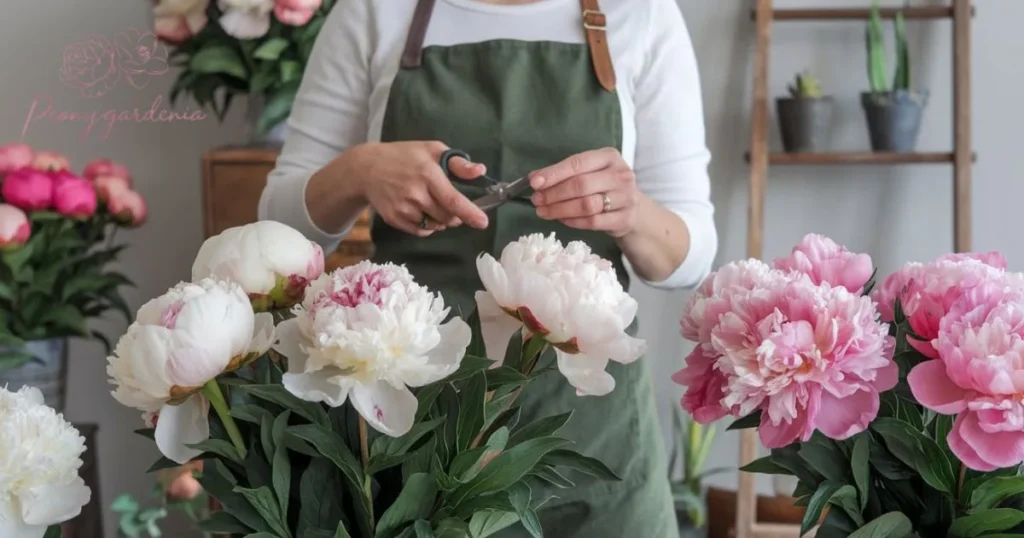
Maintaining peonies year-round involves pruning spent blooms, deadheading, and cutting back herbaceous varieties in late fall to prepare them for winter. Apply mulch around the base for root insulation, especially in colder climates. Proper care ensures healthy growth, vibrant blooms, and protection from harsh weather conditions during the off-season.
Pruning and Deadheading
Prune peonies after they finish blooming to encourage healthy growth. Remove spent flowers (deadheading) to prevent the plant from expending energy on seed production. Cut back herbaceous peonies to the ground in late fall to prepare them for winter.
Tree peonies require minimal pruning, usually just to shape the plant or remove dead branches. Regular maintenance keeps peonies looking neat and promotes better blooms.
Mulching and Winter Care
Apply a layer of organic mulch around the base of peonies in late fall to insulate the roots and protect them from harsh winter conditions. Use materials like straw, pine needles, or shredded bark for effective mulching.
In colder climates, additional protection such as a burlap covering may be needed for tree peonies. Remove the mulch in early spring to allow new growth to emerge.
Enhancing Your Peony Garden
Enhancing your peony garden involves pairing them with complementary plants like irises, roses, or delphiniums. These companions share similar growing conditions and create a visually appealing landscape. Staggering bloom times ensures continuous color, while varying textures and heights add depth, making your garden vibrant throughout the growing season.
Companion Planting
Pair peonies with complementary plants such as irises, roses, or delphiniums to create a visually appealing garden. These plants share similar growing conditions and enhance the overall aesthetic of your landscape.
Choose companions that bloom at different times to ensure continuous color in your garden throughout the growing season. The combination of textures and heights adds depth and interest.
Extending Bloom Time
To enjoy peony blooms for a longer period, plant varieties with staggered bloom times. Early, mid-season, and late-blooming peonies provide continuous flowers from spring to early summer.
Regular deadheading and proper care also prolong the blooming period. Experiment with different varieties to find those best suited to your garden.
Conclusion
Growing peonies successfully requires careful attention to their specific needs, from selecting the right location to providing proper care year-round. With their preference for full sun, well-draining soil, and consistent watering, peonies thrive when given the right conditions.
Regular maintenance, including pruning, deadheading, and mulching, helps maintain healthy growth and vibrant blooms. Managing pests and preventing diseases is key to a thriving garden. By successfully grow peonies with complementary plants and choosing varieties with staggered bloom times, you can extend their blooming period and enhance the beauty of your garden.
FAQs
When is the best time to plant peonies?
Plant peonies in the fall, between late September and early November.
How much sunlight do peonies need?
Peonies require at least six hours of direct sunlight daily.
Do peonies need a lot of water?
Peonies need deep watering once a week, especially during dry weather.
How can I prevent diseases in peonies?
Ensure good air circulation and prune dead foliage to reduce disease risk.
Can I plant peonies in shady areas?
Peonies should not be planted in shady spots, as this reduces blooming and weakens growth.
